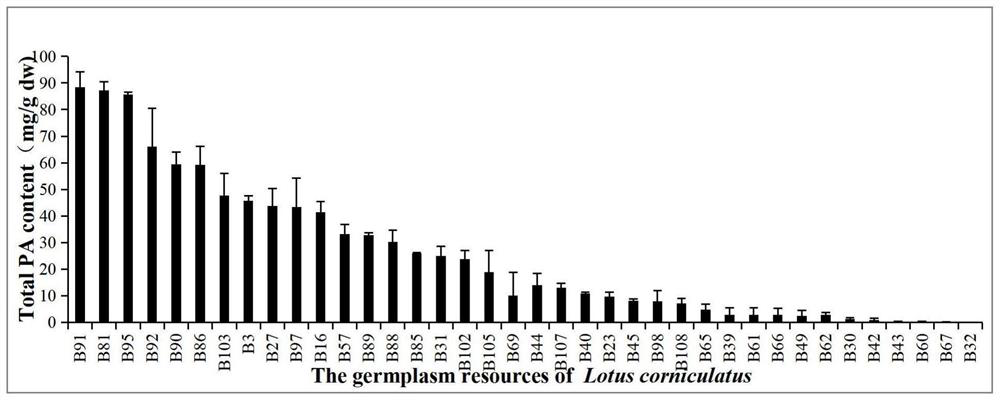Lotus corniculatus LcMYB5 gene and application thereof
A lotus root and gene technology, applied in the field of genetic engineering, can solve the problems of unclear molecular mechanism and hinder the breeding work of leaf tannin content, so as to increase the tannin content, reduce economic losses, and slow down the effect of bloat disease
- Summary
- Abstract
- Description
- Claims
- Application Information
AI Technical Summary
Problems solved by technology
Method used
Image
Examples
Embodiment 1
[0033] By collecting 38 lotus corniculatus L. germplasm resources, the tannin content in the leaves was quantitatively determined. It was found that the tannin content in leaves per gram of dry weight ranged from the lowest 0 mg to the highest 88.4 mg, as figure 1 shown. The diversity of tannin content in the leaves of these germplasm resources laid the foundation for the identification of key regulatory genes for tannin synthesis in japonicus japonicus leaves.
[0034] Meanwhile, since japonicus japonicus is diploid, its genome has also been revealed, and it has been widely used as a model plant for research. Lotus japonicus L. and Lotus corniculatus L. are also closely related. Therefore, the study also analyzed the distribution pattern of tannins in japonicus japonicus, and found that in leaves, stems and roots of japonicus japonicus, almost no accumulation of tannins was detected; a small amount of tannins was also found in flowers, Tannin is mainly concentrated in the ...
Embodiment 2
[0037] The LcMYB5 gene was cloned from the leaves of the plant material with the highest tannin content (B91). Six genome sequences of the LcMYB5 gene were cloned, namely LcMYB5A, LcMYB5B, LcMYB5C, LcMYB5D, LcMYB5E and LcMYB5F (the underlined ones are intron sequences, and the others are coding region sequences).
[0038] LcMYB5A:
[0039] ATGAGGAACCCGATAGCATCATCATCAACGAACAAGAAGAAGAGCAGTACTACAACTGGTAATGAAAATGGCACGACTGTTACTACTACTCCGTGCTGCAGCAAAGTTGGGTTGAAGAGAGGGCCATGGACACCGGAGGAAGACGAGGTGTTGGCCAGTTTCATAAGGAAAGAAGGCGAAGGTCGCTGGAGAACGCTTCCAAAAAGAGCCGGCCTCCTCCGCTGCGGTAAGAGCTGCCGCCTCCGCTGGATGAACTACCTCCGCCCCTCCGTCAAACGCGGCCAGATCGCCCCCGACGAGGAAGATCTCATCCTCCGCCTTCACCGCCTCCTCGGCAACCG GTACCTTTCTCCTCGATCGATCTTCCTTTT ATCTAGCTTAGGGTTTGCTACGAACTTTGCTTAACTAATTAATTAATTTTAAATAAACATATATATAGCTAGGG CTTGATTTAATTACACTTTATTTAATTACCATTTCATCAATCATGTTTAGGATATAGTACAACAAATTCATTTTGAA ACTAACATTAATTCTAGCAAGAAGCTTTCTTAAATAGCTTCTGGGTGTTAAAATTGATTCTGATGTTACATTTACA G GTGGTCTTTGATAGCGGGAAGAATTCCGGGAAGAAC...
PUM
 Login to View More
Login to View More Abstract
Description
Claims
Application Information
 Login to View More
Login to View More - R&D
- Intellectual Property
- Life Sciences
- Materials
- Tech Scout
- Unparalleled Data Quality
- Higher Quality Content
- 60% Fewer Hallucinations
Browse by: Latest US Patents, China's latest patents, Technical Efficacy Thesaurus, Application Domain, Technology Topic, Popular Technical Reports.
© 2025 PatSnap. All rights reserved.Legal|Privacy policy|Modern Slavery Act Transparency Statement|Sitemap|About US| Contact US: help@patsnap.com



